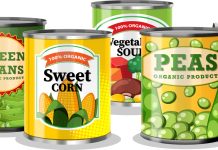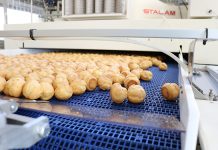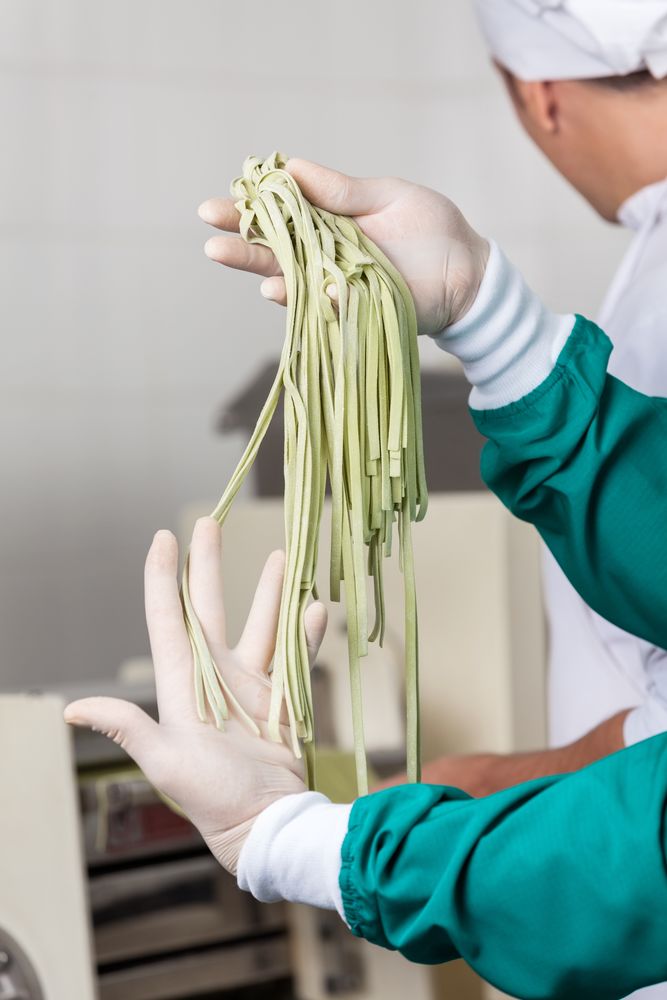
Pasta production lines must ensure stable colour and cooking times, flexible production of various types of pasta thanks to their modular design, minimum maintenance, user-friendliness and energy savings.
Modern lines cover the entire pasta production chain: From the extrusion to the final packaging, including the thermal treatment of the product. The pasta industry can count on equipment designed not only to ensure the production of high quality pasta, but also to increase energy savings, ensure a longer shelf-life and an accurate and quick cleaning of the machines, and considerably reduce overall dimensions.
With these machines the pasta factories can produce countless types of pasta: fresh, filled, laminated, dry, long and short pasta; nests; lasagna; pre-cooked, deep-frozen pasta; instant noodles; gluten-free pasta, with productions which in some cases can even reach 2000 kilos per hour. In the choice of the equipments that best suits their needs, pasta factories must analyse several aspects: the type of product and the quantity of pasta produced every day; the available space and the required treatment, without neglecting the important issue of energy savings.
The importance of thermal processes
All steps for the production of pasta, next to the raw materials used – semolina, flour, water – are of considerable importance to obtain a good final result, with special attention to the thermal processes involved. The pre-drying or pre-wrapping is made with pre-dryers (trabatti) that ensure a fast drying of the product surface, preventing it from sticking during the next steps. The drying of pasta can be static or continuous.
Most of the innovations in the production of pasta are directed to optimize the drying process. In fact, this is the most critical and difficult step in the entire pasta production process. The moisture content of pasta has to be lowered from 31-32% to 12-13%. In so doing, the finished product is hard and compact, retains its shape and can ensure a long shelf-life, typical for dry pasta. The partial elimination of water, however, is not enough to guarantee the stability of pasta, which must be dried correctly. Therefore, its internal moisture must remain uniform and constant in time. If pasta is dried too quickly, it may develop cracks, but if it is dried too slowly, it tends to spoil.
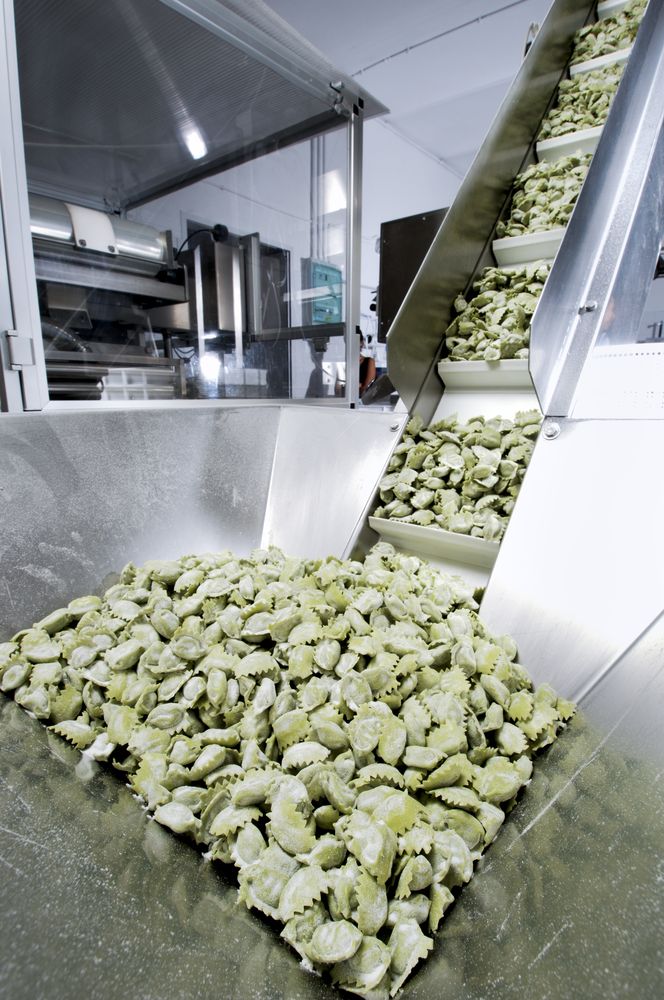
A good drying process must take into account the moisture and temperature of the air and the moisture and temperature of the product. The procedure consists in dehydrating the pasta at a low temperature, lowering the moisture content from approximately 31% to 18-17%, and then drying it at a higher temperature. In this second step, the migration speed of the remaining particles of water is slower, even due to the structure of pasta. Alternating the drying phases with resting and re-hydration phases prevents the outside surface of the pasta from drying up too much and too quickly. The pre-drying takes place in pre-dryers, which can be equipped with multi-shelves, rotary or vibrating frames, and with electric heaters powered by hot water, steam or electric resistances.
Usually they are a separate unit, except in the case of some lines for the production of short pasta. They are equipped with forced ventilation units with heat exchangers, for transferring the heat to the pasta and the moisture to the air in form of steam. The dryers available for the pasta industry can be either static or dynamic. In static dryers the drying is discontinuous and occurs in batches. In dynamic units, the drying is continuous.
The last solution is mainly implemented in large factories, because it ensures continuous operation, short stops and only a few production changes – hence more intense production cycles. Dynamic dryers provide a homogeneously dried product, which means also better quality. The thermal insulation of the drying line from the factory environment is vital. In order to prevent possible leaks, usually the pressure inside the drying line is slightly higher than the environment pressure.
The automation of drying lines is ensured by electronic control units with various programs for the optimum drying of different types of pasta. Inside dynamic dryers, the air continuously reverses its flow, for drying pasta both on the surface and on the side that rests on the tray. Pasta factories prefer high-efficiency ventilation systems providing for high-speed wrapping. Some producers, however, prefer longer drying times.
In this case, the aim is to obtain the highest stabilisation of the product next to longer life of the plants, working at temperatures ranging from 80° to 85°C. The cooling – another important step of the thermal processes involved in the production of pasta – can be with naturally cooled air or by cold water batteries. Coolers can be equipped with several shelves, which provide a development in length, or with a spiral conveyor, with a vertical development. The cooler can be combined with the freezing and pre-wrapping treatment. In this case the machine is divided in two zones that are completely independent and thermally separated to prevent the transfer of heat. Manufacturers can choose between compact units that can handle the pre-drying and the drying as well as the final cooling, and modular lines, allowing the creation of solutions with different widths and lengths, for an easier exploitation of the space available in the production area.

In any case, modern production lines are equipped with automatic systems for the management of the entire process, ensuring optimal control of the whole line parameters next to the traceability of production lots, and the on-line access to all production parameters. Temperature, one of the most significant variables, is measured by means of resistance thermometers connected to control loops. Similarly, relative humidity is monitored by a psychrometer or capacitive resistive probes. These two crucial parameters – temperature and humidity – must be adjusted and corrected in case of need. For this reason probes are equipped with digital instruments. The control on temperature and humidity also enables considerable energy savings.
Thermal treatments differ in case of fresh pasta and pre-cooked pasta. For the production of these types of pasta, two basic thermal treatments are required to ensure the product shelf-life: Pasteurization and, in some cases, freezing. With pasteurization, the high temperatures and the processing times allow the reduction of the bacterial load of the product, extending its shelf-life. The treatment can be performed with a gas pasteurizer or a horizontal steam pasteurizer or with a vertical pasteurization spiral, especially in case of very high productions. Pasteurization allows to store the pasta without adding preservatives or additives.
For a longer shelf-life, fresh pasta can undergo two pasteurization treatments, one of the product and one after the packaging. Pasta is frozen in very short times and at temperatures of minimum -18°C; this treatment is used as bacteriostatic treatment to extend the durability of a product. To this purpose horizontal or spiral tunnels are used. To reduce the overall dimensions, the market offers tunnels and spiral belt conveyor towers for the deep-freezing of fresh and pre-cooked pasta.
Automation in the sign of perfection
The lines for the production of dry pasta are the most automated among those present in the food industry. Pasta manufacturers can avail themselves of high-production equipment with batch or continuous presses equipped with vacuum extruder and static or continuous drying systems. These full automatic machines form continuous lines for the production and drying of pasta. At the beginning of the process, thanks to the use of dosing systems, the different ingredients can be automatically mixed, and the various recipes can be programmed and saved via a touch-screen panel.
For the production of long pasta, automatic presses and spreaders are used. After the spreading of pasta onto the sticks, the pasta is trimmed to the desired length, and the scraps are automatically sent to a mixing pan. Long pasta spread onto the sticks is sent to the pre-drying tunnel and then automatically placed onto automatic trolleys by robotic heads that can remove the sticks from the trolley and place them onto the stripping unit. The dryers, the ventilation system and the moisture extractor are automatically operated and controlled via PLC.
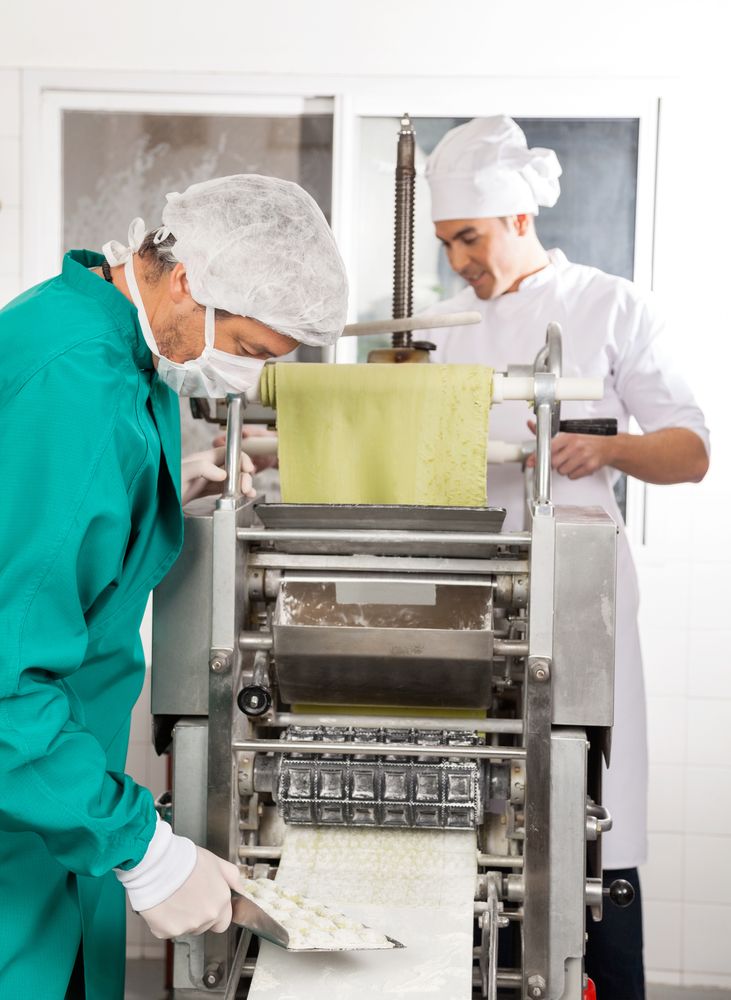
Production flexibility
Many lines for short and long pasta can be modular, hence suitable for the production of different types of pasta by adding special cutting and trimming devices and complementary machines, as for instance nesting and lasagne machines, providing for a greater production flexibility. The manufacturers of pasta processing machines offer multi-format lines, which ensure ease of use and flexible production next to small footprint.
These lines allow the production of standard pasta formats, next to special formats, with the possibility of changing the type of production in short time, without having to disassemble mechanical parts or move the machines. These multi-format lines are the ideal solution for the production of many formats in factories requiring small outputs but a large variety of pasta types. Always with the aim of ensuring the highest production flexibility, there are even multi-product cooking lines, for the production of pre-cooked fresh pasta intended for the catering and food service, for the preparation of ready meals.
Multi-format lines allow the cooking in boiling water and cooling of any type and format of pasta: Filled and unfilled pasta; long fresh, dry, frozen pasta; gnocchi; pasta sheets for lasagne and cannelloni. Thanks to the lines versatility, they can be used also for cooking vegetables, pulses, potatoes for use in ready meals.
Gluten-free: A fast-growing market
Gluten-free pasta developed for people suffering from coeliac disease is increasing all over the world. The raw materials used are: rice, maize, oats, millet, buckwheat, quinoa, amaranth. To produce gluten-free pasta made with gluten-free flours or a mixture of the same, the starch present in the flour must be gelatinized, both to make the product suitable to be transformed into pasta and to make it un-overcookable.
Pasta producing companies can directly purchase pre-gelatinized flour starch, or raw flour and transform it by means of a gelatinization process. In this case they need suitable equipment for the gelatinization of raw flours that must be integrated into their production line. This choice involves considerable investments and various problems, such as the lack of treatment homogeneity, difficulty of cleaning the machines, a decrease in production capacity and higher energy consumption.
Compared to conventional processing equipment, the main technological differences are linked to the different hydration of water and flour; the control of the degree of gelatinization, which must be accurate and modulated for each raw material processed; the disassembly of the machine to ensure optimum cleaning. Companies seek to obtain gluten-free pasta that does not clump together, reducing or avoiding emulsifying substances, such as eggs, reducing the extrusion thickness to make the product more similar to traditional pasta. Pre-gelatinized gluten-free flours are pre-cooked on conveyor belts and not in tanks. Hence, the dough does not clump together, heat and moisture are more evenly distributed. This provides for easier cleaning without product stagnation.


